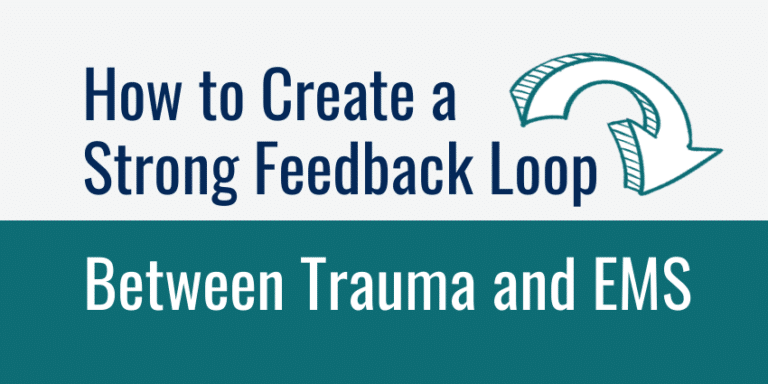Standard 7.10 from the American College of Surgeons (ACS) requires all verified trauma centers to have a process for providing feedback to emergency medical services (EMS) agencies.
Giving feedback to prehospital providers is an important part of the trauma performance improvement (PI) process, and it is essential to ensuring the safety of injured patients within a regional trauma system.
But according to Walt Trachim, trauma program coordinator for the New Hampshire Department of Safety, a strong EMS feedback loop is often more of an ideal than a reality.
“Including your EMS providers in loop closure is the standard of care in trauma, but in many centers it is at best inconsistent — simply because of the volume of patients that a lot of trauma centers see,” Trachim said. “And in many centers, EMS feedback is not necessarily done well because it has to be done quickly.”
Trachim’s background gives him a valuable perspective on the communication challenges between trauma program leaders and EMS agencies. In addition to overseeing the New Hampshire state trauma system, Trachim works part-time as an Advanced Life Support paramedic. He also has several years of experience working in a hospital Emergency Department.
Recently, Trachim shared several insights on how trauma program leaders can create a stronger feedback loop with their EMS partners.
Establish feedback “triggers”
Given the high volume of patients who arrive by EMS, it makes sense for trauma programs to focus their feedback on cases with the greatest PI potential. Trachim recommends establishing formal guidelines for identifying cases that trigger EMS feedback.

“There are three things that I would prioritize in terms of providing feedback to EMS,” he said. “No question, the first would be mortalities. Any time there is a death involved, that’s a case where you need to close the loop with EMS.”
“The second is whether or not the patient had to go to the OR,” Trachim said. “The need for a critical intervention goes hand in hand with injury severity, and EMS providers need to know how they are doing with the most severely injured patients.”
“The third would be whether or not the patient needed to be transferred out to a higher level of care,” he said. Transfer out is another marker of injury severity. In addition, these cases can be an opportunity to review transport decisions at the unit level as well as triage criteria at the system level.
“When we look at centers from the standpoint of trauma verification, these are the three things that reviewers focus on most — mortalities, OR interventions and transfers out,” Trachim said. “And as a medic, those are the things that I most want to get feedback on. More important than even knowing what the outcome was, we want to know whether or not the care we provided was appropriate and whether or not there was anything we could have done differently or better.”
EMS feedback triggers can also be based on state EMS protocols, Trachim noted. In addition, details in the ACS trauma center standards suggest issues and events that may warrant feedback to EMS partners:
- The list of required PIPS plan audit filters in Standard 7.2 includes “Compliance with prehospital triage criteria, as dictated by regional protocols” and “Delays or adverse events associated with prehospital trauma care”.
- And Standard 7.10 specifies that centers must have a process for providing feedback to EMS agencies on “accuracy of triage and provision of care”.
Leverage existing staff resources
Many trauma programs are understaffed with regard to performance improvement resources. Trauma PI coordinators and outreach specialists are often unable to keep up with their loop closure workload. In this setting, EMS feedback easily becomes a lower priority.
For trauma teams that face this issue, Trachim recommends investigating opportunities to leverage existing communication resources.
“Normally, any EMS agency has a clinical services manager,” he said, “someone who is responsible for all clinical operations including quality and performance improvement, i.e., loop closure.”
A key part of this job is facilitating communication between hospitals and EMS crews.
“For trauma programs, the clinical services manager can be your first point of contact,” Trachim said. “He or she can find the crews that were involved in an event, convey the feedback from the trauma program and let them know if there were any opportunities for improvement.”
In addition, most hospitals have an EMS coordinator. Even if trauma program leaders are already working with this individual, there may be opportunities to strengthen the relationship and further streamline communication.
“In some hospitals, the EMS coordinator deals directly with both the trauma medical director and the EMS medical director and so is able to convey feedback very effectively,” Trachim said.
Use case reviews for both feedback and training
Trachim believes that morbidity and mortality (M&M) rounds are an under-utilized opportunity to provide both general feedback to EMS providers and proactive training on prehospital trauma care.
“There is a great deal of value in setting aside time — either monthly or quarterly — to review cases, look at their circumstances, and then talk about both the positive aspects of the care provided and the things that were opportunities for improvement,” he said. “Ideally, EMS providers will have the chance to share their perspectives on the cases being discussed and provide their own feedback.”
M&M rounds can support compliance with ACS Standard 8.3, which requires trauma programs to participate in the training of prehospital personnel.
Make use of technology
All hospitals have secure email capabilities, and hospitals can use these systems to provide feedback to EMS personnel. Trachim noted that this is sometimes a source of confusion for hospital staff.
“To clarify, EMS is a covered entity with respect to privacy laws,” he said.
Beyond secure email, advanced digital information systems can provide enhanced capabilities for conveying feedback from trauma program leaders to EMS providers.
Interoperable systems that link EMS data, hospital EHR data and the hospital trauma registry facilitate communication by allowing trauma program leaders to assess EMS care using patient care reports and other EMS data sources and transmit rich feedback to EMS personnel via secure messaging.
In addition, interoperable systems allow trauma programs to easily capture and document the “evidence of communication” needed to comply with Standard 7.10.
New Hampshire Relies on ImageTrend
The New Hampshire Department of Safety has implemented ImageTrend software systems for EMS and hospital data. According to Walt Trachim, these systems facilitate robust communication between the state’s trauma centers and EMS agencies.
“The ImageTrend interface can automatically send patient outcome information from the hospital trauma registry to the EMS patient care report system. The report includes ICD-10 codes, but it is filtered in such a way that the EMS agency only receives codes that are specific to the trauma,” Trachim said. “There’s no unnecessary information that gets in the way. EMS providers only see the information that they need to see, and that’s the way it should be.”
Keep it positive
Trachim began his EMS career more than 30 years ago, when the safety culture in many organizations was very different than it is today.
“When something went wrong, you would get yanked into the training room and just get torn to shreds,” he recalled. “That was something a lot of people in EMS were afraid of. The culture in healthcare is a lot better than it used to be, but even now things like that still happen more than they should. And that’s unfortunate, because the punitive approach is a real morale buster.”
Trachim noted that EMS performance feedback should be educational and supportive and should provide a corrective action that is not disciplinary.
“Being able to provide feedback in a way that is not punitive is really, really helpful,” he said. “And it goes a long way to making sure people are willing to continue to do their jobs and take in the lessons learned in the spirit in which they’re intended.”

